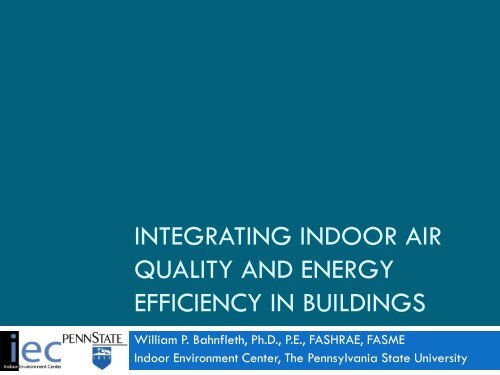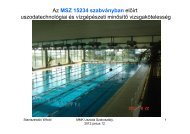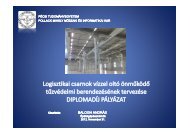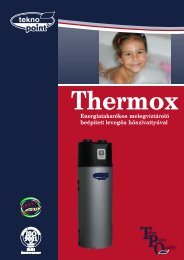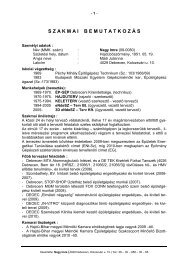Multizone Airflow Modeling Use Case Description
Multizone Airflow Modeling Use Case Description
Multizone Airflow Modeling Use Case Description
You also want an ePaper? Increase the reach of your titles
YUMPU automatically turns print PDFs into web optimized ePapers that Google loves.
INTEGRATING INDOOR AIR<br />
QUALITY AND ENERGY<br />
EFFICIENCY IN BUILDINGS<br />
William P. Bahnfleth, Ph.D., P.E., FASHRAE, FASME<br />
Indoor Environment Center, The Pennsylvania State University
Outline<br />
<br />
Connection between IAQ and energy use<br />
<br />
Importance of indoor air quality (IAQ)<br />
<br />
Current status of IAQ control<br />
<br />
Efficient IAQ technologies<br />
<br />
Integrating IAQ and energy efficiency<br />
<br />
Conclusions
Energy conservation and ambient<br />
environment are high priorities…<br />
Component efficiency<br />
Reduced system energy use intensity<br />
Stratospheric ozone depletion<br />
Global climate change<br />
<strong>Use</strong> of alternative fuels<br />
Protection of water supplies
Buildings are the largest energy enduse<br />
sector<br />
~ 40% of US primary energy use<br />
22% residential /18% commercial<br />
Source: US Energy Information Administration (2010)
Priority of energy, ambient environment<br />
apparent in law, policy, programs…<br />
<br />
US Energy Laws<br />
National Energy<br />
Conservation Policy Act<br />
(1978, amended)<br />
Energy Policy Act of 1992<br />
Energy Policy Act of 2005<br />
Energy Independence and<br />
Security Act of 2007<br />
Emergency Economic<br />
Stabilization Act of 2008<br />
American Recovery and<br />
Reinvestment Act of 2009<br />
<br />
Other Public and Private<br />
Initiatives<br />
Montreal Protocol (1987,<br />
amended<br />
Kyoto Protocol (1997,<br />
amended)<br />
Directive on Electricity<br />
Production from Renewable<br />
Energy Sources (EU, 2001)<br />
Directive on the energy<br />
performance of buildings<br />
(EU, 2002)<br />
ASHRAE Vision 2020<br />
many others…
More than half of building energy use<br />
is for environmental control<br />
US buildings, all types<br />
Space heating 37%<br />
Lighting 10%<br />
Space cooling 9%<br />
Ventilation 3%<br />
TOTAL 59%<br />
HVAC 46%<br />
Source: US DOE Buildings Energy Data Book (2010)
Residential & commercial differ, but<br />
environmental control dominates both<br />
US Residential Site Energy End <strong>Use</strong><br />
US Commercial Site Energy End <strong>Use</strong><br />
Source: US DOE Buildings Energy Data Book (2010)
“That all people should have free access to air<br />
and water of acceptable quality is a fundamental<br />
human right.”<br />
~World Health Organization, Air Quality Guidelines for Europe, 2 nd ed.<br />
“An energy declaration without a declaration<br />
related to the indoor environment makes no<br />
sense.”<br />
~Bjarne Olesen, Olli Seppänen, Atze Boerstra. Criteria for the Indoor Environment for<br />
Energy Performance Of Buildings – A New European Standard.
Importance of IEQ - asthma<br />
According to US CDC<br />
based on data collected<br />
in 2007, 2008, 2009<br />
8.2 % of population/26<br />
million people affected<br />
10.5 million missed<br />
school days<br />
14.2 million missed work<br />
days<br />
475,000 hospital stays<br />
3,447 deaths<br />
Asthma triggers (CDC)<br />
ETS<br />
Dust mites<br />
Outdoor air pollution<br />
Cockroach allergens<br />
Pets<br />
Mold<br />
Wood smoke<br />
Respiratory infections
Asthma incidence is increasing rapidly<br />
in the US and elsewhere
Healthcare and productivity costs<br />
(Fisk, W. How IEQ Affects Health, Productivity. ASHRAE J., May 2000)<br />
Potential health and productivity saving Savings, from<br />
Source of Productivity<br />
feasible IAQ and IEQ improvements<br />
Gain<br />
Potential Annual Health Benefits<br />
$Billion<br />
(1996)<br />
Savings,<br />
$Billion<br />
(2012)<br />
Reduced Respiratory<br />
Illness<br />
Reduced Allergies and<br />
Asthma<br />
Reduced Sick Building<br />
Syndrome Symptoms<br />
Productivity Gain from<br />
Lighting/ Thermal<br />
Improvements<br />
16 - 37 Million Avoided <strong>Case</strong>s of<br />
Common Cold or Influenza<br />
8% - 25% Decrease in Symptoms<br />
within 53 Million Allergy Sufferers<br />
and 16 Million Asthmatics<br />
20% - 50% Reduction in SBS Health<br />
Symptoms Experienced Frequently<br />
at Work by ~15 Million Workers<br />
6 - 14 9 - 21<br />
1- 4 1- 6<br />
10 - 30 15 - 44<br />
20 - 160 30 - 237
Put another way…<br />
The value of the health and productivity of the<br />
occupants of a building can be more than an order<br />
of magnitude greater than the cost of the energy it<br />
consumes<br />
Annual energy cost: $1 - $3/ft 2 (~€9 – €25/m 2 )<br />
Annual functional costs: $80 - $600/ft 2<br />
(~€680 – €5100/m 2 )
Poor IAQ is not a problem of wealthy<br />
countries<br />
Unvented indoor biomass cooking remains common<br />
in developing nations<br />
~2,000,000 deaths per year due to chronic<br />
exposure, mostly women and children<br />
(Smith, K. R. 2003. The global burden of disease from unhealthy buildings:<br />
preliminary results from comparative risk assessment. Proc. Healthy Buildings 2003)<br />
…and to this add concern about the role of indoor<br />
exposure in real or feared epidemics – SARS,<br />
tuberculosis, influenza
What we know about IAQ on a<br />
practical level<br />
Factors that are correlated with perceived air<br />
quality and air quality problems<br />
Dampness<br />
Ventilation rate<br />
Building materials and other sources<br />
Indoor air chemistry<br />
Not enough known to prescribe specific control<br />
levels for most contaminants and for mixtures of<br />
many interacting contaminants
State of knowledge is reflected in<br />
methods<br />
Source control<br />
Remove known hazards<br />
Local exhaust for sources that cannot be removed<br />
Task ventilation and general ventilation – dilute<br />
everything<br />
Non-specific particulate filtration – inorganic, viable<br />
and non-viable organic<br />
Moisture control – prevent mold growth
Comfort vs. Sensory Load & Ventilation<br />
Fanger hypothesized<br />
that the individual is the<br />
best sensor for air<br />
quality<br />
Defined “sensory load”<br />
in terms of the<br />
bioeffluent production<br />
of one sedentary adult<br />
Defined sensory load<br />
from material emissions<br />
and activities such as<br />
smoking in olf units<br />
Fanger, P. O. (2008) “Perceived Air Quality and Ventilation<br />
Requirements” in Indoor Air Quality Handbook, J. Spengler,<br />
J. McCarthy and J. Samet eds.
Comfort vs. Sensory Load &Ventilation<br />
1 olf sensory load<br />
(1 sedentary adult)<br />
Note definition of class A<br />
ventilation – 10 L/s-olf<br />
Fanger, P. O. (2008) “Perceived Air Quality and Ventilation Requirements” in Indoor Air<br />
Quality Handbook, J. Spengler, J. McCarthy and J. Samet eds.
ASHRAE Standard 62.1- Air Quality<br />
<br />
<br />
<br />
<br />
<br />
Additive ventilation<br />
requirements for occupants<br />
and building<br />
Minimum requirements for<br />
quality of ventilation air<br />
Adjustments for air<br />
distribution effectiveness<br />
MERV 6 particulate<br />
filtration (ASHRAE Std.<br />
52.2)<br />
Basic requirements for<br />
system design and<br />
construction
ASHRAE Standard 62.1- Air Quality
Sick Building Syndrome Symptoms vs.<br />
Ventilation Rate<br />
Source: W. Fisk, A Mirer, M. Mendell. 2009. Quantitative relationship of<br />
sick building syndrome symptoms with ventilation rates. Indoor Air
Productivity vs. Ventilation Rate<br />
Source: Seppänen, O. and W. Fisk. 2006. Some Quantitative Relations between Indoor<br />
Environmental Quality and Work Performance or Health. HVAC&R Research.
IAQ perception is affected by<br />
interactions with other IEQ parameters<br />
…and observe ~12% increase in SBS symptoms per 1ºC above 22.5ºC
Probability of Infection vs. Ventilation<br />
Rate<br />
<br />
<br />
<br />
Wells-Riley is a widely<br />
example of a model for<br />
infection risk<br />
ipqt <br />
<br />
<br />
V<br />
<br />
P 1exp<br />
<br />
<br />
<br />
v f<br />
d<br />
<br />
<br />
<br />
<br />
<br />
Relates probability of<br />
infection to infectious source<br />
strength and ventilation rate<br />
Can be generalized using<br />
equivalent ventilation rate<br />
<br />
<br />
<br />
<br />
<br />
<br />
<br />
P = proportion of new<br />
disease cases among<br />
susceptibles<br />
i = number of infectors<br />
p = breathing rate<br />
q = rate of production of<br />
infectious particles by infector<br />
t = time infectors and<br />
susceptibles share a space or<br />
ventilation system<br />
V = indoor air volume<br />
= air change rate, real or<br />
effective (v = ventilation, f =<br />
filter, d = deposition)
Current ventilation requirements<br />
Codes and standards predominantly reference<br />
subjective comfort – e.g., ASHRAE Standard 62.1:<br />
Acceptable Indoor Air Quality: air in which there are<br />
no known contaminants at harmful concentrations as<br />
determined by cognizant authorities and with which a<br />
substantial majority (80% or more) of the people<br />
exposed do not express dissatisfaction.<br />
New information on influence of IEQ variables has<br />
made little penetration into practice – e.g., LEED credit<br />
for ASHRAE 62.1 + 30%
Current minimum standards may aim<br />
too low<br />
IEQ is the cumulative impact of air quality, thermal<br />
environment, lighting quality, acoustic environment<br />
Overall acceptability multiplicative? If so, and all<br />
four target 80%, overall ~40%<br />
Fall even shorter of optimal health/productivity<br />
levels<br />
…HVAC designer assumes code provides good IAQ<br />
and then focuses on minimizing energy use/cost,<br />
perhaps too much, given the human cost.
Achieving High IAQ Efficiently<br />
Energy recovery from ventilation air<br />
Allowance for intermittent occupancy<br />
Dynamic ventilation control<br />
DOAS<br />
Air treatment as a substitute/supplement for<br />
ventilation<br />
…all permitted by ASHRAE Standard 62.1,<br />
encouraged by 90.1
USGBC-LEED<br />
Increased ventilation (ASHRAE 62.1 or CEN<br />
Standard EN 15251: 2007+30%)<br />
Dynamic ventilation<br />
Natural ventilation<br />
Low emission materials
Ventilation air energy recovery<br />
Needed in extreme<br />
cold or hot/humid<br />
climate<br />
Sensible or<br />
sensible/latent –<br />
function of climate<br />
Required ASHRAE<br />
90.1for some systems<br />
(>5000 cfm (2.4 m 3 /s<br />
and > 70% OA)
Dynamic Ventilation Control<br />
(Demand Controlled Ventilation)<br />
If properly sized, ventilation flow rate can be reduced<br />
in proportion to occupancy<br />
Can significantly reduce energy if properly<br />
implemented<br />
Control options<br />
Scheduled<br />
On/off with occupancy sensors<br />
Indirect occupancy count using CO 2 concentration (most<br />
common)<br />
Direct occupancy count (developmental)<br />
Required by ASHRAE 90.1 for some high-occupancy<br />
density spaces
Issues with CO 2 based DCV<br />
Mediocre accuracy of<br />
HVAC-grade sensors<br />
People – building<br />
division of ventilation<br />
in ASHRAE 62.1<br />
eliminates fixed set<br />
point approach<br />
Multiple spaces are a<br />
further complication
Dedicated Outdoor Air Systems<br />
100% OA<br />
Minimizes design OA<br />
requirement<br />
Reduces fan power<br />
requirement<br />
DOAS meets full latent<br />
load<br />
Parallel sensible system<br />
can operate efficiently<br />
at higher temperature<br />
Source: doas.psu.edu
Air Cleaners to Reduce Ventilation<br />
Requirement<br />
Filters for all<br />
particulates – media,<br />
electrostatic<br />
Sorbents for VOCs and<br />
other gas phase<br />
contaminants<br />
UVGI for surface and<br />
airborne biocontaminants<br />
Photocatalytic oxidation<br />
and others…
Integrating IAQ and Energy Efficiency<br />
Design emphasis is imbalanced<br />
IAQ is reduced to code ventilation rate<br />
Real effort goes into energy efficiency – evaluation<br />
and optimization of system alternatives using modeling<br />
Few simiulation tools have integrate coupled<br />
simulation of energy and IAQ<br />
In the research arena, IAQ and energy are mainly<br />
the domains of different communities that work<br />
independently
Elements of an integrated analysis<br />
Energy simulation<br />
Thermal<br />
Equipment performance<br />
Air (and contaminant)<br />
flow modeling<br />
<strong>Multizone</strong> (e.g. CONTAM)<br />
CFD<br />
IAQ performance<br />
modeling<br />
Economic analysis
Studies directed at integrated design:<br />
Fisk, et al., effect of economizer<br />
Fisk, W., D. Faulkner, O. Seppänen, J. Huang. 2005.<br />
Economic Benefits of an Economizer System: Energy<br />
Savings and Reduced Sick Leave. ASHRAE<br />
Transactions 111(2).<br />
Would not classify as a “low energy IAQ<br />
technology” because IAQ benefit, if realized, is<br />
accidental<br />
Combines energy modeling with Wells-Riley based<br />
sick leave analysis for two-story office in<br />
Washington DC.
Fisk, et al. results<br />
Health benefit is 3 – 8 times greater than energy savings
Studies directed at integrated design:<br />
Lee, et al., In-duct UVGI vs. filters<br />
Lee, B., W. Bahnfleth, and K. Auer. 2009. Life-cycle cost<br />
simulation of in-duct ultraviolet germicidal irradiation<br />
systems. Proceedings of Building Simulation 2009, the<br />
11th International Building Performance Simulation<br />
Association Conference and Exhibition, July 2009,<br />
Glasgow, Scotland.<br />
Energy analysis, Wells-Riley based sick-leave analysis,<br />
life-cycle cost analysis of UVGI air disinfection<br />
compared with equivalent (MERV 12) filter<br />
Office building in New York City
Lee, et al. scenarios<br />
Base HVAC system (minimum OA, MERV 6) + UVGI downstream of<br />
cooling coil<br />
Base HVAC system + UVGI upstream of cooling coil<br />
Base HVAC system + filtration equivalent to UVGI (MERV 12)
Lee, et al. energy and energy cost<br />
results
Lee, et al. life cycle cost results, without<br />
productivity impact - $/m 2 ($/ft 2 )<br />
In this case, showed that UVGI was less expensive than filtration than filtration for<br />
same performance and one UVGI location was substantially better than the other
Lee, et al., annual productivity benefit<br />
85% UVGI or additional MERV 12 filtration reduce relative risk by<br />
50 – 55%, savings are ~20 – 100 times cost
Studies directed at integrated design:<br />
Johansson – Life cycle optimization<br />
Johansson, D. 2009. The life cycle costs of indoor<br />
climate systems in dwellings and offices taking into<br />
account system choice, airflow rate, health and<br />
productivity. Building and Environment (44):368-<br />
376.<br />
PhD dissertation – cost-optimal system and<br />
ventilation rate selection based on equipment,<br />
energy, health/productivity cost
Johansson – representative result:<br />
optimal ventilation vs. salary in an office<br />
Conclusion: The more money you make, the better the air quality<br />
you get…especially if you have energy saving HVAC controls!
Summary<br />
Maintaining even mediocre IAQ uses lots of energy –<br />
and costs society a lot in quality of life and productivity<br />
We can do better with basic IEQ measures like<br />
ventilation, but that knowledge has not penetrated far<br />
into practice<br />
The energy and IAQ worlds do not overlap a lot – not<br />
enough yet – integration is interdisciplinary<br />
Process and tools are needed for design, and lots more<br />
research into parameters of IAQ and interactions of<br />
IEQ parameters


